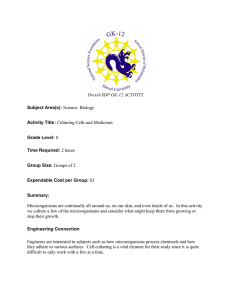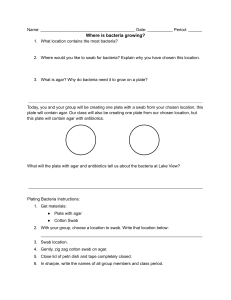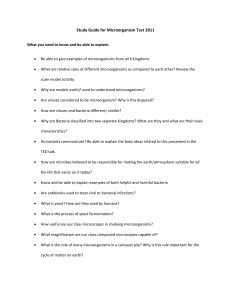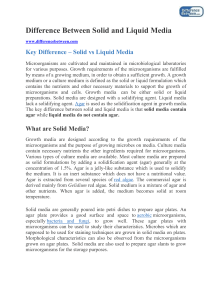Document 10519473
advertisement
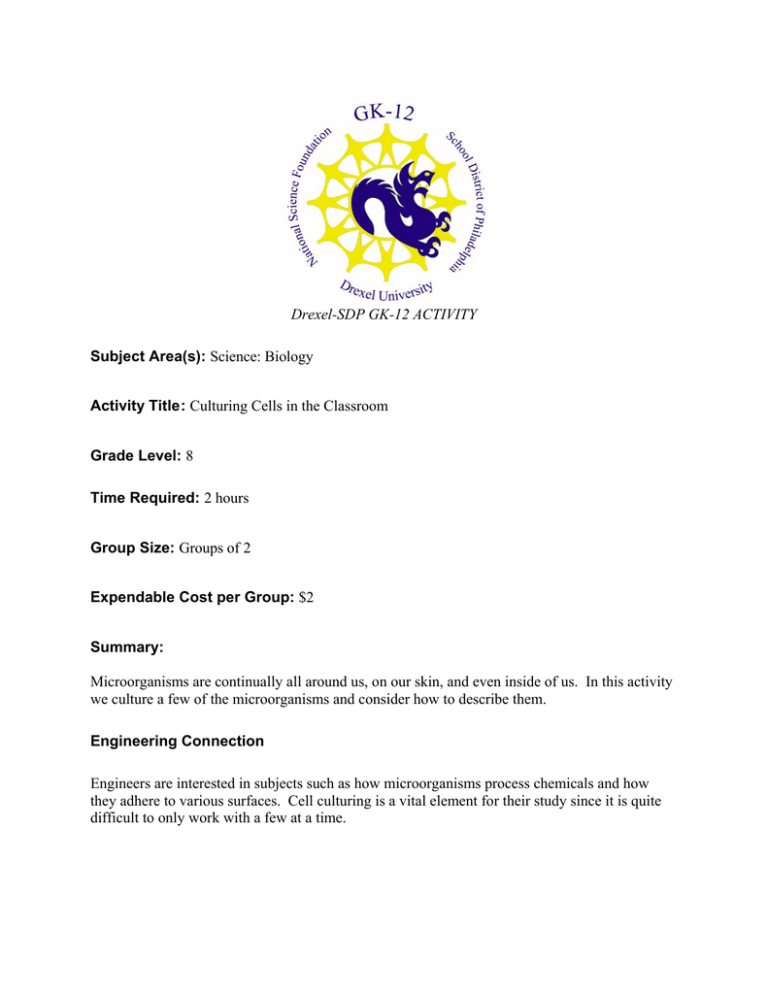
Drexel-SDP GK-12 ACTIVITY Subject Area(s): Science: Biology Activity Title : Culturing Cells in the Classroom Grade Level: 8 Time Required: 2 hours Group Size: Groups of 2 Expendable Cost per Group: $2 Summary: Microorganisms are continually all around us, on our skin, and even inside of us. In this activity we culture a few of the microorganisms and consider how to describe them. Engineering Connection Engineers are interested in subjects such as how microorganisms process chemicals and how they adhere to various surfaces. Cell culturing is a vital element for their study since it is quite difficult to only work with a few at a time. Keywords Culture Agar Petri dish Swab Educational Standards • Science: • PA 3.3.7A Describe the similarities and differences that characterize diverse living things. • PA 3.3.7B Explain that cells and organisms have particular structures that underlie their functions. Pre-Requisite Knowledge A background in very basic microbiology may be useful, though it is not essential. The mere understanding that there are organisms such as bacteria and mold that are all around us is sufficient. Learning Objectives After this lesson, students should be able to: • Understand where bacteria and mold may survive. • Explain how to culture some types of microorganims. • Compare the appearance of some types of bacteria and mold. Materials List Each group needs: • Petri dish • Marker • Cotton swab To share with the entire class: • Tape • Water Introduction / Motivation There are billions upon billions of microorganisms on our skin and on the surfaces in the classroom. They grow and multiply whenever they have a food source. There are also hundreds 2 or perhaps even thousands of different types of these organisms in our local environment. Many of these bacteria are helpful, but some are harmful. This activity will give an impression of the importance of careful cleaning of surfaces to reduce the chance of infection by harmful bacteria. Vocabulary / Definitions Word Definition Petri dish A shallow, circular container with a lid used to grow microorganisms agar A gel-like substance containing nutrients used for growing microorganisms Culture A growth of living cells or microorganisms in a controlled environment Swab A cotton-tipped tool for sampling by dabbing Procedure Background Great care should be taken in order to achieve good results! Before the Activity Sterile agar dishes may be purchases from science suppliers. With the Students 1. Choose 4 different areas to test for bacteria (doorknob, desk, etc). Generally choose areas that might be considered dirty for interesting results. 2. Mark four areas (quadrants) on the lid of the Petri dish. 3. Carefully use a swab with water on each chosen area and transfer a dab of the water to the surface of the agar. If there are bacteria on the surface, they will be transferred along with the water. Do not press on the agar surface, just lightly dab so that there is a water mark on the surface. 4. Make sure that your dabs line up with the areas that you marked on the lid. There should be one water mark in each quadrant. Label each area. 5. Tape the lid shut so that the agar doesn’t dry out. If the agar becomes dry, the bacteria will not grow. Safety Issues After the cultures are completed, many other groups observe the bacteria using microscopes. Though the great majority of bacteria and mold cultures are harmless, the safest approach is to leave the Petri dishes taped shut in case a harmful bacteria has grown. Troubleshooting Tips 3 Make sure the students very lightly dab the surface of the agar being certain to transfer some of the water yet also being certain not to disturb the agar surface significantly. Investigating Questions 1. Sketch what you see in after one week. Include this sketch in your lab report. 2. What colors and sizes are the samples? Describe this in detail. Use a ruler. 3. What other information can you record about your culture in your results? 4. Why do the bacteria colonies have different sizes and shapes? 5. Did anything else grow? 6. Did the biggest colonies come from the dirtiest places? 7. How did your results compare to the results of the other groups? Activity Extensions This activity may be extended with the activity ‘cell culturing and medicines’. Owner Drexel University GK-12 Program Contributors Ed Steager Copyright Copyright 2007 Drexel University GK12 Program. Reproduction permission is granted for nonprofit educational use Version: Mar 2007 4
